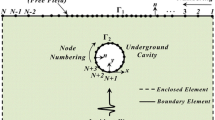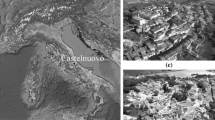Abstract
Two-dimensional site effects caused by cavities under topographical functions can considerably impact the seismic reaction of the ground surface. Due to the complexity of scattering issues by topographical features above subterranean cavity, few studies have been done in this field. In the present study, the seismic response of semi-sine-shaped canyons above a subterranean cavity (hole) of different dimensions, depths and locations is examined. The medium is assumed to have a linear elastic constitutive behavior exposed to vertically propagating incident SV and P waves. All calculations are performed using the direct boundary element technique in the time domain. It is observed that a cavity below a canyon can considerably change the ground response of the surface in different periodic bands. The seismic interaction between canyon and cavity with respect to various geometrical parameters will lead to different amplification patterns in the center and edge of the canyon. One of the most important results is the increase in amplification of long periods compared with the case of a canyon without cavity. Moreover, parametric research shows the fact that the cavity detail and canyon height, the ratio of cavity to the canyon size and cavity location impact on the seismic amplification of the canyon surface. Finally, spectral amplification coefficients of the canyon surface led by the cavity are reported for different cases of the canyon–cavity interaction.















Similar content being viewed by others
References
Ahmad S, Banerjee PK (1988) Multi-domain BEM for two-dimensional problems of elastodynamics. Int J Numer Methods Eng 26:891–911
Aki K, Larner K (1970) Surface motion of a layered medium having an irregular interface due to incident plane SH waves. J Geophys Res 75:933–954
Alielahi H (2012) Using time-domain BEM for evaluating seismic interaction between underground cavities and topographic features. PhD dissertation, Science and Research Branch Islamic Azad University, Tehran, Iran
Alielahi H, Kamalian M, Asgari Marnani J, Jafari MK, Panji M (2013) Applying a time-domain boundary element method for study of seismic ground response in the vicinity of embedded cylindrical cavity. Int J Civil Eng 11(1):45–54
Alielahi H, Kamalian M, Adampira M (2015) Seismic ground amplification by unlined tunnels subjected to vertically propagating SV and P waves using BEM. Soil Dyn Earthq Eng 71:63–79
Aviles J, Perez-Rocha LE (1998) Site effects and soil structure interaction in the valley of Mexico. Soil Dyn Earthq Eng 17:29–39
Beskos DE (1987) Boundary element methods in dynamic analysis. Appl Mech Rev 40(1):1–23
Borcherdt RD (1994) Estimates of site-dependent response spectra for design (methodology and justification). Earthq Spectra 10:617–653
Bouchon M (1973) Effect of topography on surface motion. Bull Seism Soc Am 63:615–632
Brebbia CA, Dominguez J (1989) Boundary elements an introductory course. Computational Mechanics Publication, Southampton
Carrer JAM, Mansur WJ (2004) Alternative time-marching schemes for elastodynamic analysis with the domain boundary element method formulation. Comput Mech 34:387–399
Chuhan Z, Yuntao R, Pekao OA, Feng J (2004) Time-domain boundary element method for underground structures in orthotropic media. J Eng Mech 130(1):105–116
Crichlow JM (1982) The effect of underground structure on seismic motions of the ground surface. Geophys J R Astr SOC 70:563–575
De Barros FCP, Luco JE (1993) Diffraction of obliquely incident waves by a cylindrical cavity embedded in a layered viscoelastic half-space. Soil Dyn Earthq Eng 12:159–171
Dineva P, Parvanova S, Vasilev G, Wuttke F (2014) Seismic soil-tunnels interaction via BEM part ii. Numerical results. J Theor Appl Mech 44(4):29–50
Dominguez J, Gallego R (1991) The time domain boundary element method for elastodynamic problems. Math Comput Model 15(3–5):119–129
Gazetas G, Dakoulas P (1992) Seismic analysis and design of rock fill dams: state-of-the-art. Soil Dyn Earthq Eng 11:27–61
Gizzi FT, Masini N (2006) Historical damage pattern and differential seismic effects in a town with ground cavities: a case study from Southern Italy. Eng Geol 88:41–58
Grasso S, Maugeri M (2009) The road map for seismic risk analysis in a Mediterranean city. Soil Dyn Earthq Eng 29:1034–1045
Hadely PK, Askar A, Cakmak AS (1989) Scattering of waves by inclusions in a non-homogeneous elastic half space solved by boundary element method. Tech Rep NCEER 89:0027
Hatzigeorgiou GD, Beskos DE (2001) Transient dynamic response of 3-D elastoplastic structures by the D/BEM. In: Beskos DE, Brebbia CA, Katsikadelis JT, Manolis GD (eds) Proceedings of the XXIII international conference on the boundary element method, Lemnos, Greece
Israil ASM, Banerjee PK (1990) Advanced time domain formulation of BEM for two-dimensional transient elastodynamics. Int J Numer Methods Eng 29:1421–1440
Israil ASM, Banerjee PK (1990) Two-dimensional transient wave propagation by time domain BEM. Int J Solids Struct 26:851–864
Israil ASM, Banerjee PK (1992) Advanced development of boundary element method for two-dimensional dynamic elasto-plasticity. Int J Solids Struct 29:1433–1451
Jain DL, Kanwal RP (1979) Scattering of elastic P and SV waves by a rigid elliptic cylindrical inclusion. Int J Eng Sci 17:941–954
Kamalian M, Gatmiri B, Sohrabi-Bidar A (2003) On time-domain two-dimensional site response analysis of topographic structures by BEM. J Seismol Earthq Eng 5:35–45
Kamalian M, Jafari MK, Sohrabi-Bidar A, Razmkhah A, Gatmiri B (2006) Time-domain two-dimensional site response analysis of non-homogeneous topographic structures by a hybrid FE/BE method. Soil Dyn Earthq Eng 26(8):753–765
Kamalian M, Gatmiri B, Sohrabi-Bidar A, Khalaj A (2007) Amplification pattern of 2D semi-sine-shaped valleys subjected to vertically propagating incident waves. Commun Numer Meth Eng 23:871–887
Katsikadelis JT (2002) Boundary elements: theory and applications. Elsevier Science Ltd, New York
Kawase H (1988) Time-domain response of a semi-circular canyon for incident P SV and Rayleigh waves calculated by the discrete wave number boundary element method. Bull Seismol Soc Am 78:1415–1437
Kawase H, Aki K (1989) A Study of the response of a soft basin for incident S P and Rayleigh waves with special reference to the long duration observed in Mexico City. Bull Seismol Soc Am 79:1361–1382
Kontoni DPN, Beskos DE (1993) Transient dynamic elastoplastic analysis by the dual reciprocity BEM. Eng Anal Bound Element 12:1–16
Lee VW (1977) On deformations near a circular underground cavity subjected to incident plane SH-waves. In: Proceedings of the application of computer methods in engineering conference vol II. University of Southern California, Los Angeles, Calif, USA, pp 951–962
Lee VW (1988) Three-dimensional diffraction of elastic waves by a spherical cavity in an elastic half-space I: closed form solutions. Soil Dyn Earthq Eng 7(3):149–161
Lee VW, Karl J (1993) Diffraction of SV waves by underground circular cylindrical cavities. Int J Soil Dyn Earthq Eng 11(8):445–456
Lee VW, Manoogian ME (1995) Surface motion above an arbitrarily shaped underground cavity for incident SH-waves. J Eur Assoc Earthq Eng 8:3–11
Lee VW, Trifunac MD (1979) Response of tunnels to incident SH-waves. J Eng Mech Div 105(4):643–659
Lee VW, Chen S, Hsu IR (1999) Antiplane diffraction from canyon above a subsurface unlined tunnel. ASCE J Eng Mech 25(6):668–675
Lee VW, Manoogian ME, Chen S (2002) Antiplane SH-deformations near a surface rigid foundation above a subsurface rigid circular tunnel. Earthq Eng Eng Vib 1(1):27–35
Liang JW, Liu ZX (2009) Diffraction of plane SV waves by a cavity in poroelastic half-space. Earthq Eng Eng Vib 8(1):29–46
Liang J, Zhang H, Lee VW (2003) A Series solution for surface motion amplification due to underground twin tunnels incident SV waves. Earthq Eng Eng Vib 2(2):289–298
Liu Q, Zhao M, Wang L (2013) Scattering of plane P SV or Rayleigh waves by a shallow lined tunnel in an elastic half space. Soil Dyn Earthq Eng 49:52–63
Luco JE, De Barros FCP (1994) Dynamic displacements and stresses in the vicinity of a cylindrical cavity embedded in a half space. Earth Eng Struc Dyn 23:321–340
Manoogian ME (2000) Scattering and diffraction of SH waves above an arbitrarily shaped tunnel. SET J Earthq Technol 37(1–3):11–26
Mansur WJ (1983) A time-stepping technique to solve wave propagation problems using the boundary element method. PhD Dissertation Southampton University
Marrero M, Dominguez J (2003) Numerical behavior of time domain BEM for three-dimensional transient elastodynamic problems. Eng Anal Bound Elem 27:39–48
Ohtsuki A, Harumi K (1983) Effect of topography and subsurface in homogeneities on seismic SV waves. Earthq Eng Struct Dyn 11:441–462
Partridge PW, Brebbia CA, Wrobel LC (1992) The dual reciprocity boundary element method. Computational Mechanics Publications, Southampton and Boston
Parvanova SL, Dineva PS, Manolis GD, Wuttke F (2014) Seismic response of lined tunnels in the half-plane with surface topography. Bull Earthq Eng 12(2):981–1005
Rodrıguez-Castellanos A, Luzónb F, Sanchez-Sesma FJ (2005) Diffraction of seismic waves in an elastic cracked half plane using a boundary integral formulation. Soil Dyn Earthq Eng 25:827–837
Rodrıguez-Castellanos A, Sanchez-Sesma FJ, Luzon F, Martin R (2006) Multiple scattering of elastic waves by subsurface fractures and cavities. Bull Seismol Soc Am 96(4A):1359–1374
Sanchez-Sesma FJ (1985) Diffraction of elastic SH waves by wedges. Bull Seism Soc Am 75(5):1435–1446
Sanchez-Sesma FJ (1987) Site effects on strong ground motion. Soil Dyn Earthq Eng 6(2):124–132
Sanchez-Sesma FJ (1990) Elementary Solutions for response of a wedge-shaped medium to incident SH and SV waves. Bull Seism Soc Am 80(3):737–742
Sgarlato G, Lombardo G, Rigano R (2011) Evaluation of seismic site response nearby underground cavities using earthquake and ambient noise recordings: a case study in Catania area, Italy. Soil Eng Geol 122:281–291
Sica S, Russo AD, Rotili F, Simonelli AL (2014) Ground motion amplification due to shallow cavities in nonlinear soils. Nat Hazards 71:1913–1935
Smerzini C, Aviles J, Sanchez-Sesma FJ, Paolucci R (2008) Analytical solutions for the seismic response of underground structures under SH wave propagation. American Institute of Physics
Smerzini C, Aviles J, Sanchez-Sesma FJ, Paolucci R (2009) Effect of underground cavities on surface earthquake ground motion under SH wave propagation. Earthq Eng Struct Dyn 38(12):1441–1460
Soares D Jr, Mansur WJ (2007) An efficient stabilized boundary element formulation for 2D time-domain acoustics and elastodynamics. Comput Mech 40:355–365
Sohrabi-Bidar A, Kamalian M, Jafari MK (2010) Seismic response of 3-D Gaussian-shaped canyons to vertically propagating incident waves. Geophys J Int 183:1429–1442
Trifunac MD (1972) Scattering of plane SH waves by a semi-cylindrical canyon. Earth Eng Struct Dyn 1:267–281
Wang G, Dai1 L, Liu D (2007) A study on the scattering field of SH-waves in a Topographical Area Consisting of a Semi-Cylindrical Hill and a Subsurface Horizontal Hole Proc IMechE Vol 221 Part K: J Multi-body Dynamics
Wang L, Luo Y, Xu Y (2012) Numerical investigation of Rayleigh-wave propagation on topography surface. J Appl Geophys 86:88–97
Wong HL, Trifunac MD (1974) Surface motion of a semi-elliptical alluvial canyon for incident plane SH waves. Bull Seism Soc Am 64:1389–1408
Wong HL, Trifunac MD (1974) Scattering of plane SH waves by a semi-elliptical canyon. Earth Eng Struct Dyn 3:159–169
Yiouta-Mitra P, Kouretzis G, Bouckovalas G, Sofianos A (2007) Effect of underground structures in earthquake resistant design of surface structures Dynamic Response and Soil Properties Geo-Denver: New Peaks in Geotechnics
Yu CH, Dravinski M (2009) Scattering of plane harmonic P SV or Rayleigh waves by a completely embedded corrugated cavity. Geophys J Int 178(1):479–487
Zhang C, Zhao C (1988) Effects of canyon topography and geological conditions on strong ground motion. Earth Eng Struct Dyn 16:81–97
Zhao C, Valliappan S (1993) Incident P and SV wave scattering effects under different canyon topographic and geological conditions. Int J Num Anal Methods Geomech 17(2):73–94
Author information
Authors and Affiliations
Corresponding author
Rights and permissions
About this article
Cite this article
Alielahi, H., Kamalian, M. & Adampira, M. A BEM investigation on the influence of underground cavities on the seismic response of canyons. Acta Geotech. 11, 391–413 (2016). https://doi.org/10.1007/s11440-015-0387-7
Received:
Accepted:
Published:
Issue Date:
DOI: https://doi.org/10.1007/s11440-015-0387-7




